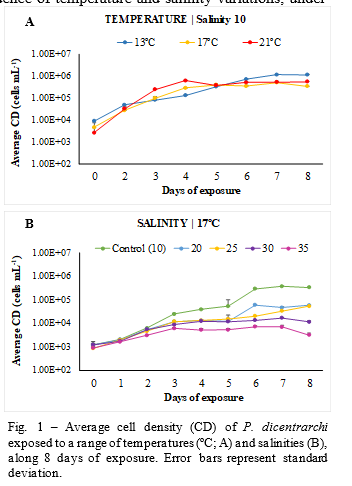EFFECT OF TEMPERATURE AND SALINITY ON A TURBOT PARASITE – APPROACHING CLIMATE CHANGE IMPACTS
Turbot (Psetta maxima) production in marine Recirculating Aquaculture Systems (RAS) is relevant to the global aquaculture market (~60 kT in 2016). However, its intensive culture promotes the proliferation of opportunistic pathogens and occurrence of severe diseases like Scuticociliatosis, which is responsible for fish outbreaks. The evolution of such disease may be tailored by abiotic stress factors, which tend to be aggravated under climate change scenarios (CCS). In this context, the previewed water temperature raise can boost pathogens development while simultaneously suppressing the immune system of fish, thereby worsening the already existing problem. On the other hand, salinity levels are also expected to raise in the Atlantic Ocean, thereby reinforcing the need to assess its impacts on scuticociliates reproduction. Hence, this work aims to identify the influence of temperature and salinity variations, under CCS, on the proliferation of Philasterides dicentrarchi isolated from a turbot RAS.
The tests were performed in 24-well plates with an initial cell density of 2x104 cells mL-1 of P. dicentrarchi isolated from turbot in a local saltwater aquaculture unit. A range of temperatures (13 – 21ºC) and salinities (10 - 35) were tested in triplicate, both individually and combined. The growth of P. dicentrarchi was daily monitored during 8 days of exposure. For that, P. dicentrarchi cells were count in a Neubauer chamber, being plotted as average cell densities in function of the exposure time (i.e., growth curves; Fig. 1) or as growth rate.
In particular, higher temperatures enhanced the proliferation of P. dicentrarchi during the exponential growth phase, whereas increased salinity levels reduced cell densities. Hence, previewed CCS for seawater temperature represents a threat to turbot aquaculture production if fish infected with P. dicentrarchi. However, the use of higher salinities may help to counteract this effect, potentially without significant impacts on turbot development given the wide range of culture conditions supported by this flatfish species.

